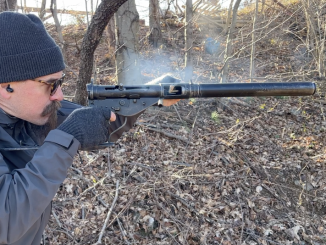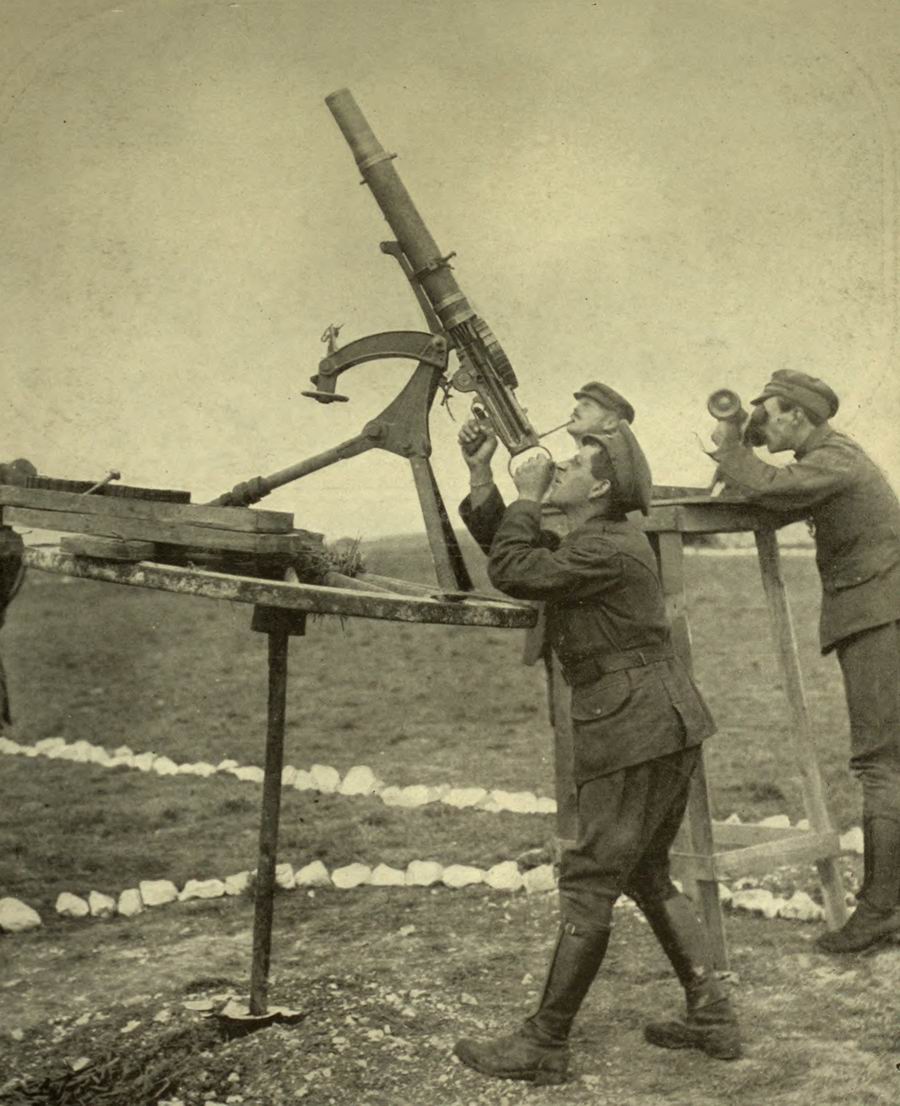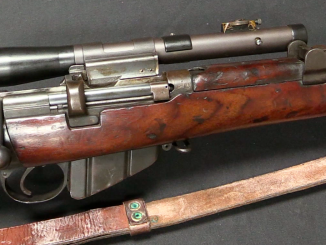The British entered World War One with a technically excellent rifle, with lots of bells and whistles. By 1916, the war was taking a previously unimaginable toll on the industrial capacity of the Empire and rifle production had to be economized. This led to the adoption of the MkIII* pattern of the Lee Enfield, to reduce cost and speed up production. The MkIII* omitted the windage adjustments on the rear sight, the front and rear volley sight elements, and the magazine cutoff. Around the same time, stock discs stopped being stamped with unit information (to avoid giving military intelligence of troop distribution when rifles were captured) and eventually deleted entirely.
The Pattern 1907 bayonet was also changed, although this does not coincide with the MkIII* rifle. In 1913, the British decided to delete the quillon from the standard bayonet. A great many bayonet with quillons were already in service, and those would be used in World War One, although many were modified in the field to cut off the quillons to avoid them hanging up on barbed wire or other obstacles.




Thoroughly enjoyed this series on the Lee rifles. I think I knew or had read about most of the information but so nice to have it all together and so well explained. Have you thought of bringing it all together in “Lee The Movie”
I believe that you may be in error about to whom this rifle was issued. Companies were indicated by an initial letter- A,B,C, etc.
2/1 was an expansion battalion of the Cambridgeshire regiment, formed after the war started. The 2/1 were not sent to France. The Cambridgeshire regiment was a “Territorial” regiment, what we’d call a reserve unit.
I agree British Army companies are designated by letters generally . I believe some units use other names but never to my knowledge numbers . The 2/1 would traditionally mean 2nd Battalion 1st Cambridgeshire Regt . A TA unit . I don’t where the 2\1 were deployed during The Great War
https://www.forces-war-records.co.uk/units/1713/cambridgeshire-regiment/
2/1st Battalion
Sept 1914 Formed at Cambridge and then moved to Peterborough as part of the 207th Brigade of the 69th Division.
Feb 1915 Moved to Bury St. Edmunds to replace the 1/1st Battalion of the East Midland Brigade of the East Anglian Division.
April 1915 Returned to Peterborough and rejoined the 207th Brigade of the 69th Division.
June 1915 Moved to Newmarket.
Nov 1915 Formed the 4/1st Battalion.
June 1916 Move to Harrogate and then Middlesbrough.
May 1917 Moved to Carburton Near Ollerton.
08.10.1917 Moved to Canterbury and transferred to the 200th Brigade of the 67th Division.
Mar 1918 Disbanded.
R.E. used company numbers.
Before WWI and during the early years of the war, Territorial Army soldiers could only be sent outside Britain if they volunteered. The volunteers for overseas duty were organized into the “first line”, the home defense soldiers into the “second line” units. 1/1 Cambridgeshire would have been the first line, 2/1 Cambridgeshire the second line.
I was going to comment the same thing. 2nd 1st Battalion.
I am researching the actual date for the introduction of the MKIII* as I own a time capsule BSA MKIII which appears to be an * overstamp . It is dated 1916 and has the stock disc, magazine cut off, adjustable rear sight, but no volley sight. All matching numbers ID’d to Royal Marines (RM) and with German capture marking to butt found on Russian and French rifles captured by Germany, no post war British markings as it has been in Germany since WW1.I think the changes were phased in over a period of time and may vary depending on manufacture.
You’re exactly right, the III* modifications were eliminations of manufacturing steps, to be done as convenient to the maker. So there is no real rhyme or reason to exactly when they stopped bothering to put the dial sight on, or rough out the stock for it, or stop milling for the cut off- or when receivers from the bin reflected the changes.
I had a SMLE MK III*. BSA 9/1917. No protective rear sight ears, the cuts in the upper handguard filled in. The whole stock was rather drastically sanded, so I guess it had been around. This was in Australia, so perhaps it was issued to the AIF, was brought back and saw use in Great War Chapter 2. Last few inches of bore were rough, bolt was smooth as butter and the rifle shot 2 MOA consistently. Hope it saved some Digger’s lives.
At one time, I had a Mk 3* rifle w/ magazine cutoff. Sadly it was out of headspace and I sold it.
Great video lesson. Thank you sir!
My III* stamped B.S.A.Co 1917 has windage adjustable rear sight
I’m in a club that shoots these SMLE’s and other ex-military bolt actions of the same era regularly. Although the SMLE has a legendary reputation it has some practical issues. The two piece stock means it has very pernickety bedding which has to be set up carefully for it to shoot well and this needs fairly regular attention. More of a problem for the target shooter than the soldier in the field. This problem was partially fixed with the No. 4 design.
The big one is the rimmed cases. We shoot rapid fire events and so many times charger clip loading (even by experienced Lee Enfield users) results in the so-called rim-over jam. Sorting it usually throws you out of placing anywhere in the competition. Something that doesn’t plague Mauser and Springfield shooters and almost certainly would have led to many deaths in combat, when men are trying to reload under conditions of extreme stress.
Rim jams are not a issue with properly made ammo. That is with proper bevel on the case rim. You should check Bloke On The Range videos on that matter.
These are the relevant videos concerning Lee-Enfields and rimlocks:
https://youtu.be/MOYTdoQkFrM (Proper British milspec cases)
https://youtu.be/BZlamWhwbi4 (Modern S&B commercial ammo)
“…so many times charger clip loading (even by experienced Lee Enfield users) results in the so-called rim-over jam…”(С)
It is called:
“He bought a rifle…
He bought ammunition…
He saved money on the user manual…” LOL
https://lee-enfield.org/enfield-info/53-charger-clips
“Rim jams are not a issue with properly made ammo”
The one thing you are not going to get with hastily built factories and equally hastily trained personnel. Standards go down in favor of production level. Still usable but not necessarily up to spec
“On 15 August, County Territorial Associations began raising second-line units to replace those scheduled for foreign service. The ranks of the second line were filled by those territorials who could not or did not accept the Imperial Service Obligation. In November, associations started raising third-line units to take over from the second-line units the responsibility for providing replacement drafts to territorial combat units. Territorial battalions were numbered according to line so that, for example, the three lines of the 6th Battalion, Gloucestershire Regiment, became the 1/6th, 2/6th and 3/6th Battalions. In May 1915, territorial divisions were numbered in order of their deployment overseas; the East Lancashire Division, for example, became the 42nd (East Lancashire) Division.[79]
Second-line units immediately assumed that the third line would take over their home-based duties, in the belief that second-line divisions would be deployed overseas. Many second-line battalions refused to take recruits who had not accepted the Imperial Service Obligation, a practice that was not officially sanctioned until March 1915 when the option to enlist only for home service was abolished. The deployment of second-line units overseas was officially endorsed in mid 1915. Until the third line was ready, the conflicting demands to supply drafts, defend the homeland and prepare for deployment caused problems for the second line.[80][81][g] In May 1915, Kitchener informed the War Cabinet that the second line was so denuded of trained men as to render it unreliable for home defence. Only in 1916 could the War Office promise that the second line would no longer be trawled for replacements to be sent to the first line. By this time, second-line battalion establishments had been reduced to 400 men, less than half the number normally serving in an infantry battalion at full strength. It took on average 27 months to prepare a second-line formation for active service, compared to eight months for the first line, and the second line often lacked sufficient weapons and ammunition.[83][84] The desire among the second-line commanders to maintain a level of training and efficiency in readiness for their own deployment led to friction with their first-line counterparts, who accused the second line of holding back the best men and sending sub-standard replacements to the first line.[85]”
On a perhaps brutal pragmatic level (which after all was that which they faced with and was their aim). What was the manufacturing-production gain i.e. 1%, 5%, x more rifles ?